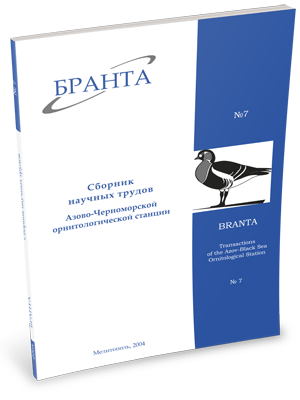
Transactions
of the Azov-Black Sea Ornithological Station



Shag (Phalacrocorax aristotelis) in the south of Ukraine
Beskaravayny M.M.
Mediterranean Shag (Phalacrocorax aristotelis desmarestii Payraudeau, 1826) inhabits the south of Ukraine (the Crimea). Distribution and numbers of this species in the Crimea are well studied. However features of ecology, breeding and behaviour of the bird still remain poor known.
Material and methods
The investigation covered the southern coast of the Crimea from Yalta to Mount Opuk, regular studies took place in the Mys Martyan Reserve and the Karadag Reserve. Counts were executed by counting birds from a cutter and from coast, and along the coastal routes when it was outside breeding sites.
Results of 70 spring/summer and 140 winter counts were processed. More 40 nests were measured and/or examined. For the study there was used material from personal archives (M.A.Voinstvenskiy, Yu.V.Kostin), reports (N.N.Shcherbak), diplomas (G.D.Serskiy, M.A.Dudova) and students' observations (about 160 hours).
Distribution and habitat
Shag breeds along the Black Sea coast of the Crimea: Tarkhankut Peninsula and Kerchenskiy Peninsula, the southern coastline - from Cape Chersones to Cape Kiik-Atlama. Outside breeding period birds stay within limits of their breeding range. Sometimes they reach to the Sea of Azov. A breeding habitat is rocky-coast relief (precipices and rocky islets): nests are built in deep bags, cracks or on open areas. Feeding habitat is chiefly a strip of water zone of 100-600 meters wide.
Numbers and dynamics
The largest breeding group is on Tarkhankut (500-600 pairs). Kerchenskiy Peninsula is inhabited by 55 pairs; breeding colonies at the southern coast consist of 1-2 to several dozens of pairs: the largest colony is in the Karadag Reserve (up to 94 pairs). Total numbers in the Crimea include 1,500 - 2,000 birds, where the breeding population is near 900 pairs. Numbers of nonbreeding birds out of the breeding sites are strongly varied (concentrations up to 120 birds). Winter density at the south-western coast reaches 0.2 ind/km, while at the south-eastern coast it is averagely 5.2+0.6 ind/km.
Breeding
Breeding cycle begins in late February (building of nests, copulation). Items using to build nests are diverse (land vegetation, algae, reed). The laying starts in the first ten days of March; a clutch contains 2-5 (more frequently 3) eggs, average size 63.1±0.6x37.1±03 mm. Incubation lasts 28 days. А brood includes 1-3 nestlings, averagely 2.0±0.1. Fledglings leave nests from late May to July-August. So Shag is characterized by early start and extended period of breeding. Breeding terms of different pairs in one season fluctuate within 2-2.5 months, and strongly vary between years. Since late summer juveniles together with adult birds keep near breeding areas.
Behaviour
Shags spend much time at the marine aquatic area. They collect building material either on land (shoulders of rocky precipices) or at the sea. Completion of building and repairing of nests continues during incubation. Copulation and change of an incubating partner often follows preening of head and neck feathers to female. Breeding birds are aggressive toward approaching birds of their own and other species. Nestlings of 12-day age show aggressive reaction. Birds gather for night roost at 19.00-19.30. Shag is characterized by little disturbance, and during incubation allows a man approaching at the distance up to 6-7 m.
Interspecies relation, predators
Shags breed close to Yellow-legged Gull, Rock Dove, Peregrine, Kestrel, Jackdaw and Starling. In winter they make large congregations with Cormorant. Predators are Yellow-Legged Gull, Eagle Owl, Carrion Crow, and possibly Raven. There was recorded strong infection of birds by helminthes.
Diet
Shag is a specialized ichtyophage. Predominantly consumes gobies (occurrence in stomachs is 71.2%), occasionally crustaceans and molluscs. In a total the diet includes not less than 15 fish species, at least 13 of them are bottom-dwelling and coastal forms. Pelagic shoal fish is of secondary importance.
Biocoenotic and practical value
The role in functioning of ecosystems is small. Relation with vegetation is limited by taking some part of biomass for building nests (at least 16 species of higher plants and 6 species of algae). Daily consumption of fish by all Crimean population is about 720 kg.
Human influence and conservation
Reasons for decreasing numbers are disturbance, direct ruination of nests, oil pollution, and occasional death in fish nets. Colonies of Shags at the southern coast are in the recreation area. Even some reserves are used for recreation (the Karadag Natural Reserve with the second in numbers nest group). Shag is listed in the Red Data Book of Ukraine (1994), registered in 3 Crimean reserves, and breeds in two of them: the Karadag Natural Reserve and Opukskiy Reserve (in a total they are 150 pairs or 14-16% of all Shag quantity in the Crimea). Seven breeding colonies are in the reserves and natural memorials, five in IBAs, nine is in areas prior for biodiversity conservation in the Crimea. Measures of conservation include protection of breeding sites, and effective protection of the present reserves (the Karadag Reserve), as well as limits for any water vehicles near breeding colonies within 600 m of coastal acquatic zone.
Read the paper in a PDF file